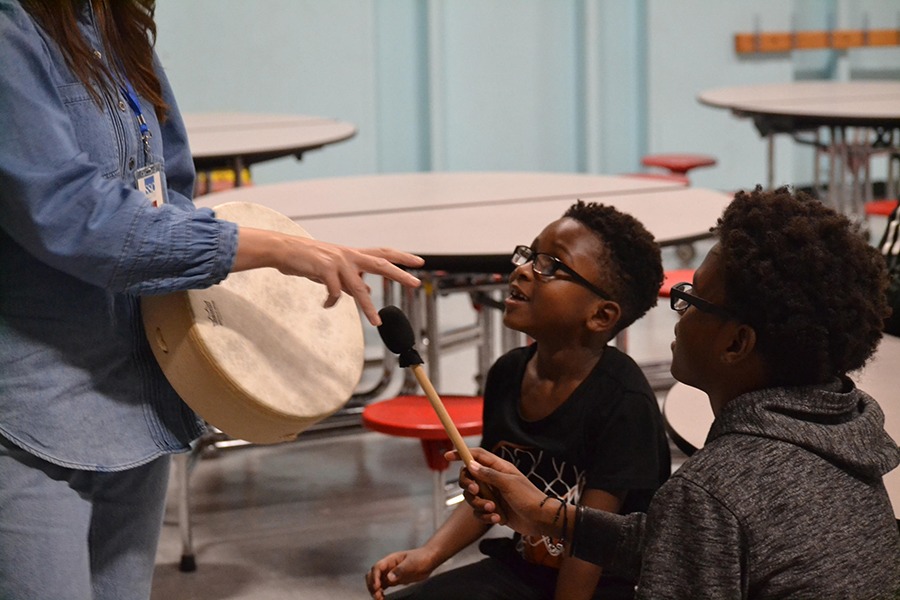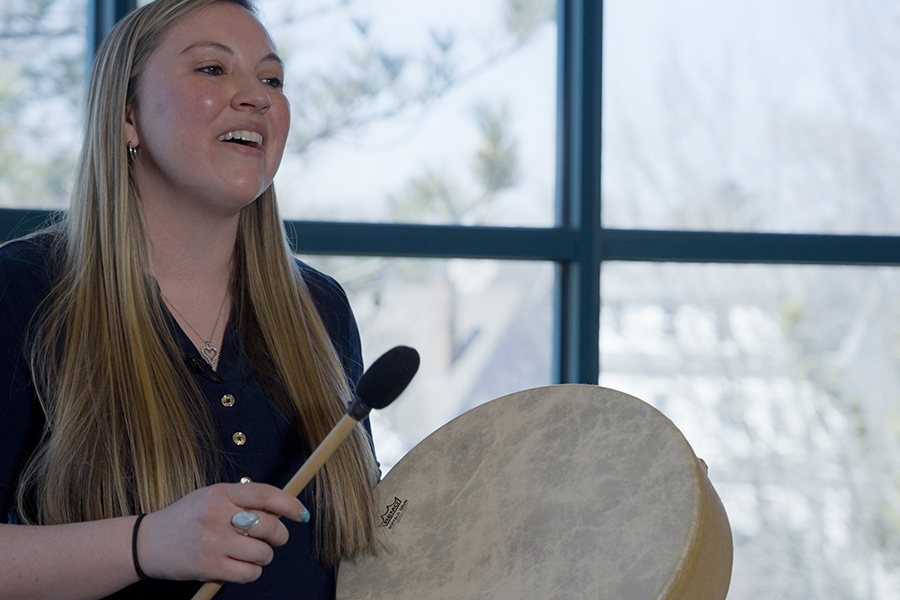This Massachusetts Nonprofit Found a Way to Boost Literacy–By Bringing Music into the Classroom
On a typical week at The Angelo School in Brockton, Mass., Kaitlyn Mazzilli, a dance movement therapist and volunteer music teacher, walks into a kindergarten classroom singing and banging a large drum. The students in the classroom aren’t surprised or skeptical, but react with excitement. Throughout Mazzilli’s lesson, with surprising consistency for a kindergarten class, they sit rapt with attention. And by the time she leaves, one 45-minute period later, they’re usually asking her to stay to do another song.
“I have to tear myself away because I’d love to stay longer,” Mazzilli says. “But of course we have to move on to the next classroom.”
The instruction the kids get in that brief period once a week is not just a source of joy for those students. Within the field of education, it’s increasingly understood that integrating the arts into core curriculum subjects, such as literacy and math, improves students’ ability to grasp these areas of study. But asking teachers to take on this additional, interdisciplinary skill all on their own can be a major challenge.
That’s where Mazzilli comes in. She’s an instructor for ImagineARTS, a program by the South Shore Conservatory that supports literacy in schools across the city of Brockton through arts integration. The lessons provided by Mazzilli, and other instructors in the program, help students grow as learners, help teachers in providing lessons day-to-day, and even help the families of those students to bring more music into their lives.
According to teachers and staff, the program’s impact sticks with those students for the rest of their time at the school, shaping part of the next generation of South Shore residents. As the program has received the support of local partners in Brockton, it’s increasingly being recognized as a promising model for how to seamlessly integrate arts-based education into schools. And for a city that was hit hard by the pandemic, the success of the program could offer hope for the future.

Courtesy: ImagineARTS
Learning and Growing
The program’s critical presence in Brockton’s schools has grown quickly, from a simple class at one Brockton school to a weekly part of several Brockton schools’ academic schedules. That keeps instructors like Mazzilli busy.
“I go to three schools each week, and each school has between five to seven kindergarten classes. So in a couple of days, I’ll travel between the three schools, and the total ends up being 18 classes over the course of three days. So it’s about six each day,” Mazzilli says.
A key innovation at the heart of the program that has helped make it so critical is that, as an arts-integration program, it’s not simply a music program. It’s a fusion of literature and music that can expand children’s understanding of both, while supporting a school’s required curriculum.
“The folks who designed the program were people who had worked as music educators in the public school system before, folks with a ton of early childhood education experience,” says Holly Jennings, director of the ImagineARTS program. “And I’m working closely with the teachers, the reading specialists, and the principals at the school, so that when we’re creating our curriculum, we’re doing it with them and making sure that it’s age appropriate and developmentally appropriate.”

The Core Lesson
A typical ImagineARTS lesson is built around storytime–an instructor reads a selected story out loud for the kids, and follows up the story with musical activities. The ImagineARTS instructors get the kids participating and moving with a variety of dances, sing-alongs, and use of basic instruments, addressing developmental needs while helping them gain a deeper understanding of the story that they’ve just heard.
“We’re singing, we’re moving our bodies with creative movement, we are improvising by mimicking the sound of the animals in the story. And that’s the creative arts piece of the goals for that activity,” Jennings says, noting that they also practice more traditional reading comprehension skills as well.
These different ways of interpreting the story not only make a greater impact on the students–they can also make it more accessible for a broader variety of learning styles, including those who do not speak English.
“There are some students who have trouble accessing the curriculum,” Jennings says. “So that’s one reason it’s important to incorporate different types of learning. For example, bringing in music into teaching can make learning fun and exciting and memorable for students … especially for the English language learners, it’s just immediately accessible to them in a way that they can succeed in the classroom.”
ImagineARTS also supplements their weekly visits to each of the kindergarten classes they support with monthly and yearly programming. Once a month, they bring in a visiting arts instructor to introduce the kids to new musical instruments and offer inspiration for new musical pursuits. Annually, they offer professional development for teachers on how to incorporate music into their lessons, and they also bring in parents and older siblings to see what students are learning in class. They even provide free books to students, looking to further their education not just through each 45-minute period, but by building a larger, ongoing, shared education.
“They get three books in the course of the year: one in the fall, one in the winter, one in the spring,” Mazzilli says. “And I found that the parents are so grateful that they have three books by the end of the program that the children are able to keep forever. And I always ask the children, ‘Who do you read this book with?’ And they’re so excited to share that they read it with their brother and sister, or they read it with their mom or dad. And that’s another way that ImagineARTS connects families together.”

Courtesy: ImagineARTS
A Well-Rounded Curriculum
Altogether, that makes for a big impact on schools like the one Mazzilli regularly visits, The Angelo School. And those effects go beyond literacy. For many students at The Angelo School, kindergarten is their first formal school environment, and coming out of their shell can be difficult. ImagineARTS creates the kind of environment that enables a more positive interaction.
“After what we’ve been through as a society for the last four or five years, the social emotional part of education is a big deal. And when ImagineARTS comes in, and they’re teaching their skills through music, it’s very soothing and relaxing,” says John Kelly, principal at The Angelo School. “When I walk in the classroom, I see 100 percent of the kids engaged in learning with smiles on their faces and taking part in the lessons and expressing themselves through the music … I always say that when the kids are enjoying what they’re doing, they’re going to be more focused and more engaged in it. And they clearly enjoy their time with ImagineARTS.”
The positive impact of that environment isn’t limited to improving engagement in students. In Mazzilli’s experience, the lessons can be a critical way to break through to students who have developmental delays in socialization. She describes one student who had a transformational experience through ImagineARTS.
“This was a student who was primarily nonverbal and had communication delays, but she became a leader in her classroom,” Mazzilli says. “She was able to model the songs, and she was singing, which blew the teachers away.”
ImagineARTS also bring music-based approaches to other concepts in education, making it valuable for kindergarten teachers throughout the day.
“When we learn rhyming words, they’re able to remember the rhyming songs that Miss Kaitlyn taught them,” says Jen Hartford, a teacher at The Angelo School. “In math, we do dramatic play, counting subtraction and addition with our fingers to different songs.” ImagineARTS even provides songs that make everyday behavioral tasks fun for students, such as lining up or heading back to their desks.

Courtesy: ImagineARTS
The Larger Lesson
It’s part of the promise of ImagineARTS that it wants to expand that impact to as many students as possible in Brockton and beyond. Jennings pursues a sustainable growth plan to spread to other schools in Brockton and the South Shore.
“It’s important that we always grow in a way that is maintainable,” Jennings says. “We never want to add a partner school in one year and then have to drop them the next because we just didn’t get the funding.”
That support, in addition to publicly available funds, comes most critically through community partners. According to Jim Dunphy, president and CEO of South Shore Bank, a mutual bank that supports programs like ImagineARTS in Brockton, the program deserves support because of its transformational potential for the city of Brockton.
“I grew up in a small town in a border community of Brockton, and Brockton was one of the main areas that we would go for entertainment or shopping,” Dunphy says. “I’m very fortunate that now I get to help run a business that, when we do well, we get to support that community. And one big part of our focus is, we’ve been involved in bringing arts and culture to young folks, and giving them experiences like the ImagineARTS Program, we are supporting the future of Brockton.”

Support for these kinds of programs has only become more critical as Brockton seeks to rebound from the pandemic, according to Brockton’s mayor, Robert F. Sullivan.
“It’s helping create the building blocks for success for the next generation,” Sullivan says, noting that Brockton was hit particularly hard by loss of life during the pandemic–and Brockton’s greatest asset is its people. “The city of Brockton is an awesome city, made up of 106,000 people. We’re not a wealthy city. If you look at our financial ledger, we’re not wealthy in terms of dollars. We’re wealthy with people … and ImagineARTS is something that, I’m going to give kudos to South Shore Bank–they came to us, they welcomed the idea of helping Brocktonians, starting with our youngest, and I’m just proud to be able to say that, if you looked at its success, it’s a proven commodity, and we’re just going to build upon that and more kids are going to benefit. And South Shore Bank and Jim Dunphy, their leadership has been phenomenal.”
For local leaders like Dunphy, who is also helping to create a business leadership program in Brockton, it’s a part of shared efforts in making sure the future of Brockton is the best it can be.
“We’re always looking for ways that we can help our communities, and as we’re more successful, we’re able to demonstrate what a local bank can do in your community,” Dunphy says. “As clients come and work with us, then we can give back some of that support, and it becomes a great back and forth.”
As ImagineARTS continues to grow, and the children it has helped grow into adults, the way it impacts the South Shore is making it an essential part of the effort to bring Brockton to its full potential. And for Mazzilli, she already knows she’s had an impact. She sees it in her older students, by the way they react to her years after they’ve left kindergarten behind.
“It brings me so much joy to see some of the first graders and older students who remember ImagineARTS,” Mazzilli says. “It’s just the joy that comes across their face when they see me walking by the hallway, and the excitement in their voice as they say hello.”
Click here to learn more about ImagineARTS and the South Shore Conservatory. And click here to learn more about South Shore Bank.


